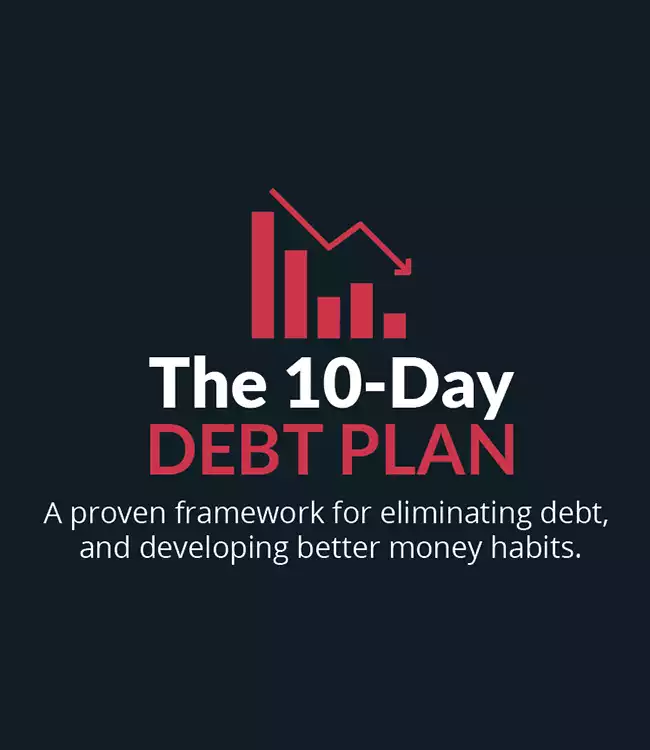Millions of us have student loan debt, and it hampers our progress towards financial independence. Let’s get rid of it! We’ll teach you how to handle your student loans like a pro.
Because student loan debt is such a serious issue and because there are so many different ways to deal with it, we wanted to bring in an expert. Travis Hornsby from Student Loan Planner to explain how to handle your student loans.
Trillion with a T
You may have heard that there is a student loan debt crisis, but maybe you don’t know just how bad the crisis is. It’s this bad.
The average college graduate with a bachelor’s degree left school with $28,446 in student debt in 2016, according to data from the Institute for College Access & Success.
There are 44.5 million student loan borrowers in the U.S., and they owe a collective $1.5 trillion as of March 2018, according to the Federal Reserve.
And the impact of all that debt isn’t only economic. Travis has worked with people who felt so hopeless because of the amount of student loan debt they had, that they had considered suicide.
Student loan debt is nearly impossible to discharge, and when you have it to the tune of six figures, it’s not surprising that people feel hopeless. But there are options available to help you handle your student loans.
How to Handle Your Student Loans Like a Pro
There are lots of options available that will help you pay off your student loans more quickly and more cheaply. There are even programs to have them forgiven. Eventually. These programs are only available for federal student loans, not private.
Student Loan Repayment Options
You don’t have to start repaying most loans until six months after you’ve graduated, dropped out, or are in school less than half-time. If your grace period ends and you’re struggling with payments, there are programs to help. Use this calculator to see what your payments under these options will be.
- Revised Pay As You Earn– Caps the amount of your monthly payment at 10% of your discretionary income.
- Pay As You Earn– Caps your monthly payments at 10% of discretionary income. There are some restrictions. Your payment under the plan must be less than it would be under a standard ten-year payment plan. You must also have been a new borrower as of October 1, 2007, and taken a disbursement of a Direct Loan by or after October 1, 2011.
- Income-Based Repayment Plan- Bases payments on your income and is evaluated each year. If your income goes down, the payment does too. Monthly payments are capped at 10% of discretionary income if your loan money was received after July 1, 2014, and 15% if received before.
- Graduated Repayment Plan- Allows interest-only payments for the first two years. Payments will be lower, but the loan will be more expensive as none of those payments pays principal.
- Income Contingent Repayment- Uses two methods to calculate your payments and allows you to pay whichever is less.
The first is your Adjusted Gross Income over the poverty line for your family size multiplied by 20%. That number is divided by 12 to get the monthly payment amount. The value of your loan isn’t a factor.
The second calculation includes the loan value and income factor as determined by the federal government and a constant multiplier also determined by the government.
Student Loan Forgiveness Programs
After paying back loans for several years, you may be eligible for forgiveness.
- Public Service Loan Forgiveness Program- Available to those in public service. You must work full time for a qualified employer which includes the government and qualifying not-for-profits. You must make payments for ten years under a qualifying plan which include RPAYE, PAYE, IBR, and Standard Repayment.
- Revised Pay As You Earn- Limits payments to 10% of discretionary income. Undergraduate loans are forgiven after 20 years of on-time payments and graduate loans after 25. There’s no income eligibility requirement for REPAYE. As long as you have qualifying loans, you’re eligible.
- Pay As You Earn Forgiveness- Limits payments to 10% of discretionary income. The plan forgives the remaining loan after 20 years of on-time payments.
- Income Based Repayment Forgiveness- Limits the number of payments to 10-15% of discretionary income. Once you’ve made on-time payments for 20-25 years (the number of years depends on what year the loans were disbursed) the remainder is forgiven. To qualify, your payments must be lower than they would be under a Standard Repayment Plan. The Repayment Estimator at Studentloans.gov will show you if you meet that requirement.
- Income-Contingent Repayment Forgiveness limits payments to 20% of discretionary income or the amount paid with a fixed 12-year plan, whichever is less. Once borrowers have made on time payments for 25 years, the remaining loan is forgiven. As long as you have qualifying loans, you’re eligible.
- Federal Perkins Loans Cancellation and Discharge Program forgive a percentage of the debt for each year of service. Borrowers must have worked full time for one year or more in an eligible field.
Eligible occupations include education and public service careers like nurses, military, and law enforcement, and public defenders. There are other occupation specific student loan forgiveness programs available.
This free course outlines a proven framework that thousands of people have used to eliminate their debt, develop better money habits, and start building a secure financial future.
Refinancing and Consolidation
If you have private student loans or for some other reasons are not allowed to participate in any of the above programs, what can you do?
Debt Consolidation
If you have multiple loans with multiple lenders, it can be a hassle to keep track of them all. And if you don’t, you can miss payments which may result in late fees or even default.
Consolidating means you take out one new loan to pay off your existing loans. You can extend the payment term which will lower your monthly payments but cost you more in interest over the life of the loan.
When you consolidate federal student loans under Direct Loan Consolidation, you don’t lower your interest rate. The rate is equal to a weighted average of the interest rates on your current loans and rounded UP to the nearest 1/8th %.
Student Loan Refinancing
When you refinance, you can lower your interest rate. You can also increase or decrease the life of the loan and choose from a fixed or variable rate loan. Earnest will refinance your student loan. It only takes about two minutes to see what rates you’re eligible for and does not affect your credit score.
Earnest offers interest rates starting at 2.47% for variable loans and 3.89% for a fixed rate. If your current interest rate is higher than those, refinancing can save you thousands of dollars.
Do note that while Earnest and some other student loan refinance companies offers some programs to help borrowers who have trouble paying off their loans, they are nowhere near as comprehensive as those offered under the government, and when you refinance federal loans, you lose access to all of those programs.
You Get Turned Down
All lenders have their own criteria they require potential borrowers to meet, but in general, you need a credit score around 680 which is in the “Fair” category. Lenders will want to know your debt to income ratio which is a number that shows you much of your income goes to paying off debt.
Each lender has different DTI requirements but the lower the number, the better. A DTI below 40 is something to shoot for.
To get the number, divide all of your monthly debt payments by your gross monthly income.
If your number is above 40%, try to bring it down before you apply by paying down any other debt you have or increasing your income.
Lenders will also want to see proof of steady employment and adequate income. If you aren’t making enough to qualify on your own, some lenders allow borrowers to use a qualified co-signer.
Most lenders require that you graduated. Most lenders also require that you graduated and that you be a U.S. citizen or permanent resident.
Check the lenders’ Eligibility Requirements before you apply. While entering in your information to get loan offers does not affect your credit score, actually applying for a loan does so you only want to apply if you’re likely to be approved.
There is no limit on how many times you can refinance your student loans so when your credit score makes a big leap upwards, or your debt to income ratio goes down, shop around and see if you can get even better terms than you did with your prior refinance.
Don’t Do These Things
Some people make what was a manageable situation unbearable, and some make an already bad situation worse when they make these common mistakes when paying off their student loans.
If you’re struggling to pay your loans, don’t just stop paying them! If you default on student loans you could be sued, your credit will be destroyed for years, and you may incur even more debt in the form of fees and fines.
Call your lender and ask what arrangements can be made. You may be able to defer loans or enroll in some of the repayment programs we’ve listed.
Don’t take on more debt! Some people are in a tearing hurry to buy a house or a new car when they still have thousands of dollars in student loan debt.
Even if you’re able to pay back your loans at their current rates, if your interest is high, look into refinancing options that will save you money over the term of the loan.
Making Extra Payments
If you’ve come into some extra money, you might want to start paying more than just the minimums on your student loans to kill them off faster. This is not a bad thing but make sure you’re doing it right.
If you have both private and federal loans, pay more on the private loans. The interest rates are probably higher than they are for your federal loans and if you run into problems in the future, you have many more options for help with federal loans than private.
Don’t just pay randomly. Use the stacking method just as you would for credit card debt. List each debt according to the interest rates and focus on paying the loan with the highest rate first.
Each lender is different, but if you’re paying more than the minimum and don’t tell the lender where you want the extra money applied, the lender will decide for you.
Lenders are required to apply extra payments to interest first. The Consumer Financial Protection Bureau has a sample letter you can send to your lender explaining how to apply your payments.
Understand the Tax Implications
Having your student loans forgiven after a couple of decades of making payments can be a huge relief, but that relief might be tempered when the Tax Man comes knocking.
If you started with $100,000 in loans and under one of the eligible repayment plans had the last $20,000 forgiven, that $20,000 is considered “a taxable event.” It will be considered income for the year it was forgiven.
As with everything tax-related, there are some programs and situations excluded from this including loans forgiven through Public Loan Forgiveness and Teacher Loan Forgiveness Program.
Currently, loans forgiven based on death and disability are also excluded.
This is Too Much Work!
Damn, this stuff is complicated! If you can’t be bothered, Student Loan Planner can help you out. They make custom plans to help you pay off your student loan debt based on your situation. On average, the company helps borrowers save $62,000 over the life of their loans!
Pay Off Debt or Invest?
LMM stresses how vital it is to invest and to invest early. But if you have student loan debt, what should be your priority, the debt or investing?
If the interest rates on your loans are greater than 7%, paying the debt off should be your focus. The average return over time you can get when you invest in the stock market is about 7% per year, so you’re not going to make more than you’re paying out in interest on your loans.
The exception to this is a 401k with matching. That match is free money so if your employer offers it, contribute just the minimum you need to get the match.
The other step you want to take before tackling the debt is to have at least $1,000 saved for an emergency fund. You don’t need to save the recommended six months worth of expenses until you’ve paid off the debt but having no emergency fund at all is dangerous.
Now, about that 7%!
Always Do the Math
We know that student loan debt and any other kind of debt can be stressful and scary, but a big part of what makes it scary is not knowing exactly where you stand. Before you start to panic, always do the math.
When you don’t know exactly how much debt you’re in, you can’t make a plan to attack it. The number might be smaller than you thought or it might be bigger. But knowing will make you feel better because it’s the first step in taking control of it.
To drift is Hell, to steer, Heaven.
Tweet ThisNo matter what kind or how much debt you have, there is a way out.
Show Notes
Schlafly Kolsch: A classic, golden ale.
Vincent Van Couch: An American wild ale.
Thank you to our sponsors: Ahrefs and LinkedIn Jobs
Ahrefs is the secret to LMM’s success. They cover every aspect of SEO. If you want to start a blog or improve traffic to an existing one, this is the tool. You can win a free Lite annual subscription by tweeting @ahrefs and @MoneyMattersMan and telling us why you should be our winner.



